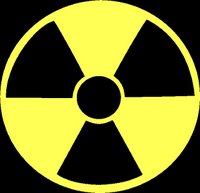January 3
 Today is the 47th anniversary of the first nuclear reactor accident in United States history. On 3 January 1961 the three-megawatt SL-1 facility, an experimental reactor located about 40 miles west of Idaho Falls, was destroyed in roughly four milliseconds as a power surge vaporized the water surrounding the reactor core. Army specialists John Byrnes and Richard McKinley and Navy Electrician's Mate Richard Legg were killed; elements from the reactor core were blown into their bodies, which were horribly disfigured and pulsing with radiation. One of the men was impaled and pinned to the ceiling by a reactor shield plug, while the other two were blown sideways against a shielding block. Clean-up crews discovered that the bodies of the men -- one of whom survived for a brief period of time after the explosion -- were emitting at least 500 roentgens per hour even after their clothing had been cut away.
Today is the 47th anniversary of the first nuclear reactor accident in United States history. On 3 January 1961 the three-megawatt SL-1 facility, an experimental reactor located about 40 miles west of Idaho Falls, was destroyed in roughly four milliseconds as a power surge vaporized the water surrounding the reactor core. Army specialists John Byrnes and Richard McKinley and Navy Electrician's Mate Richard Legg were killed; elements from the reactor core were blown into their bodies, which were horribly disfigured and pulsing with radiation. One of the men was impaled and pinned to the ceiling by a reactor shield plug, while the other two were blown sideways against a shielding block. Clean-up crews discovered that the bodies of the men -- one of whom survived for a brief period of time after the explosion -- were emitting at least 500 roentgens per hour even after their clothing had been cut away. After much dispute over the final disposition of their bodies, Byrnes, McKinley and Legg were buried in lead-lined caskets, encased with concrete. The reactor itself received a similar farewell.
***
On 3 January 1924, a shower of red worms descended on the Swedish town of Halmsted. As described by Charles Fort in his 1931 chronicle of the bizarre, Lo!,They were red worms, from one to four inches in length. Thousands of them streaking down with the snowflakes -- red ribbons in a shower of confetti -- a carnival scene that boosts my discovery that meteorology is a more picturesque science than most persons, including meteorologists, have suspected.The "worms of heaven," he concluded, "seem to be a jolly lot."
Had Benito Mussolini been living in Halmsted, we can be assured that the jolly red worms would have been lined up against a wall and shot. One year after the Swedish deluge, Il Duce dissolved the Italian Parliament and rescinded all democratic liberties, bringing the force of the state to bear in subsequent years upon communists, socialists, trade unionists, and anarchists among others. As he explained in La Dottrina del fascismo, which he wrote with Giovanni Gentile in 1932,
Fascism wants man to be active and to engage in action with all his energies; it wants him to be manfully aware of the difficulties besetting him and ready to face them. It conceives of life as a struggle in which it behooves a man to win for himself a really worthy place, first of all by fitting himself (physically, morally, intellectually) to become the implement required for winning it. As for the individual, so for the nation, and so for mankind. . . .The Fascist would, we presume, hold January 3 in special contempt. Today, in addition to everything else, is the Festival of Sleep.
This positive conception of life is obviously an ethical one. It invests the whole field of reality as well as the human activities which master it. No action is exempt from moral judgment; no activity can be despoiled of the value which a moral purpose confers on all things. Therefore life, as conceived of by the Fascist, is serious, austere, and religious; all its manifestations are poised in a world sustained by moral forces and subject to spiritual responsibilities. The Fascist disdains an "easy" life.
Labels: fascism, nuclear disasters